
Art by John Byrne and Terry Austin
I grew up in a household where at least a few comic books were usually around. This is the first comic book I remember really noticing. I must have been around six or seven years old since the book was originally published in December of 1978. I'm not surprised this issue was in my household because my parents were Doctor Strange fans. It was the cover that most captured my young attention. The story it contained, the first chapter of a two-parter, was beyond me. But I was as familiar with the symbolic figures of the Rider-Waite Tarot deck as a seven year old could be maybe. Even then I knew I was looking at something interesting. The presence of this comic book as a young child might explain a lot. It doesn't get much more blatant then this.
Looking at this cover now I'm struck by several factors. It is an illustration by the eighties powerhouse team of John Byrne and Terry Austin. I have great respect for Byrne's artwork (though not so much as a writer, where I find his approach to be callow and destructive) and his pencils always looked their best inked by Austin. The issue was written by Chris Claremont. Claremont, Byrne and Austin were the team responsible for classic X-Men epics like "The Dark Phoenix Saga" and "Days of Future Past".
The image itself is very powerful and the symbolism it invokes entirely apt. Marvel's major initiatory character Spider-Man (see Tingly Intuition) is depicted bursting forth from Doctor Strange's Orb of Agamotto, an artifact related to the Doctor's All-Seeing Eye of Agamotto, and a literal and figurative stargate. A magician's crystal ball is for certain a Looking Glass. Spider-Man as the Fool too is absolutely appropriate. The Fool is the initiate's card. They say wisdom begins with accepting one's own foolish nature. With great power comes great responsibility. Doctor Strange (see Doctoring Art Gotic Part II) is a natural as the Magician, adept in all the elements of the Minor Arcana. Ms. Marvel is The Star (see The Great Marvel Mysteries Part Three), connected to Virgo and the Goddess.
That's Clea on the High Priestess card and this is completely appropriate as well, especially within the context of this storyline. Clea is Doctor Strange's student and lover, and the niece of the god-like Dormammu. The figure on the Death card is a fairly obscure Doctor Strange villain, Silver Dagger. Here is perhaps the only real miscast, though it is understandable why Byrne made this choice. The symbolism of the Tarot plays a key role in the storyline, including Doctor Strange as the Magician and Clea as the High Priestess but reversed. Spider-Man as the Fool and Ms. Marvel as the Star are not specified, but in the story the card representing Silver Dagger is the Hierophant reversed. This is much more appropriate as Silver Dagger, a character created by Steve Englehart, is a fanatical Catholic driven mad by reading a book of magic called "The Shiatra Book of the Damned", an item clearly inspired by Lovecraft's Necronomicon (Doctor Strange refers to the Shiatra Book inspiring the Necronomicon in part two of this storyline, reversing the relationship). Reading the Shiatra Book conveyed great sorcerous power to Silver Dagger, which he utilized to hunt down and murder other spell-casters who he considered to be sinners and heretics. He is literally a Hierophant reversed.
In a previous encounter in Doctor Strange's own title, Silver Dagger became trapped within the Orb of Agomotto, in an Otherworld termed an "Unreality". The "Marvel Team-Up" issues relate his escape, achieved by drawing the astral bodies of Clea and Doctor Strange in so that he could exit. Within the Orb Doctor Strange faced Clea at her full and darkest potential, very similar in fact (but far less involved) to the Dark Phoenix Saga Claremont and Byrne presented a couple of years later. Naturally, as this is a team-up title, all would have been lost if fate had not delivered both Spider-Man and Ms. Marvel to the scene to lend Doctor Strange assistance. Of great interest here is the depiction of the Unreality within the Orb.
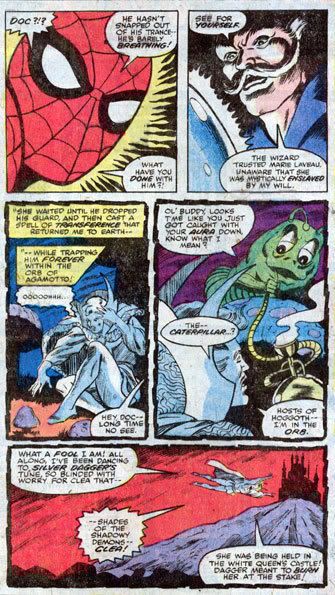
Art by Howard Chaykin
The Land Inside the Looking Glass. According to a flashback this continued the model established by Englehart in Silver Dagger's original appearance in the Doctor Strange series, which I have never read, but would love to get my hands on. It seems that the Orb's Unreality is one and the same as Wonderland. It also appears to be highly plastic, confirming at one point to the home dimension of Clea (the Dark Dimension) and then to the inner-world of Spider-Man. The hookah-smoking, mushroom-perched Caterpillar of Wonderland is remarkably similar to the initiatory, Mugwump Spider-Man.
In Doctoring Art Gotic Part IV I mentioned the symbol combining potential of the big two comic book publishers' various team-up titles. For a long span of issues DC's "The Brave and the Bold" involved primarily Batman teaming up with random characters of the DC pantheon. The same was done in "DC Comics Presents" with Superman pre-Crisis, and again by Byrne for a little over a year in "Action Comics" post-Crisis. There is certainly pure Gold created in some of these serial, chemical weddings. "DC Comics Presents" notably includes a visit by Superman to Eternia where he met He-Man and the Masters of the Universe during a time when DC held a license for that property. The long-running "World's Finest Comics" featured the singular pairing of Batman and Superman, who shared many weird adventures.
Besides "Marvel Team-Up", Marvel also had "Marvel Two-In-One" which featured pairings with the Thing from the Fantastic Four. There was even a couple of Giant Size issues and a regular series titled "Marvel Super-Villain Team-Up" in the late seventies, featuring Doctor Doom mostly with the Submariner except in the last few issues where Doom worked with Magneto and the Red Skull. Most of these titles, including "World's Finest" which started in 1941, lasted no later then 1988, and that was Byrne's take on "Action", a title which continued but in the form of a weekly (very weakly) anthology series. The rest had all been canceled by late 1986. This coincides with what I consider to be the Iron Age of American comic books. Interestingly all of these titles have been revived recently in one way or another.
"Marvel Team-Up" is of particular interest given recent topics on Spider-Man, Doctor Strange, and the X-Men. Spider-Man was the primary figure of the title. The few issues that did not have Spider-Man featured either the Hulk or the Promethean Human Torch (see The Life Pyrotic), and in one case the two together. The initial three issues were in fact all team-ups between Spider-Man and the Human Torch. A panel from the first issue, March 1972, speaks volumes.
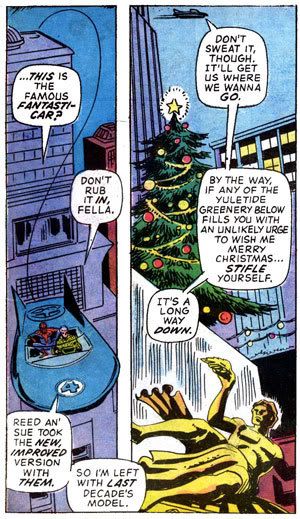
Art by Ross Andru
The villain they faced in issue #1 was Marvel's Sandman, an enemy shared by Spider-Man and the elemental Fantastic Four. The name "Sandman" alone refers to initiation patterns, the altered-state of consciousness achieved while sleeping, and also a Man of the Earth, an Adam. In "Marvel Team-Up" #2 Spidey and the Torch again fought Sandman as well as two other members of The Frightful Four. The wonderful Frightful Four are every bit as elemental as the Fantastic Four. The anti-gravity expert the Wizard is Air, Paste-Pot Pete is Water, and the Inhuman Medusa is Fire. Interesting here that the element missing from the Frightful Four in this issue is the single one present from the Fantastic Four. The issue also features the extra-dimensional, Cosmic Rod wielding Annihilus. In this case Annihilus is the fifth element, the ether or astral substance associating with Kiby's universal Cosmic Energy.
In issue #3 the Torch and Spider-Man faced the vampire Morbius. Vampires inherently embody life-after-death initiation rites. The story continued into issue four which featured Spider-Man and one of the last appearances of the original X-Men before the second generation was introduced in 1975. The adventure ended with Spider-Man planting a kiss on Jean Grey/Marvel Girl/Phoenix, the true High Priestess of the Marvel Mysteries.
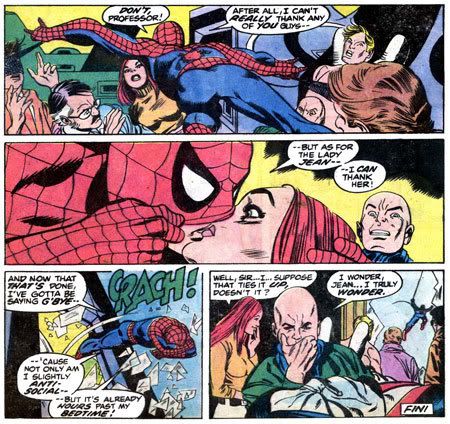
Art by Gil Kane
Interesting that without knowing the context one might naturally assume Spider-Man was kissing Mary Jane Watson in the panel above. Depending on who is rendering them, they are more or less identical in appearance. Claremont, Byrne and Austin did an interesting story with Mary Jane in "Marvel Team-Up" #79. Unearthed artifacts from the Hyborian Age (described as the Age following the fall of Atlantis, c. 10,000 years ago) were on display in a New York City museum, including an amulet that possessed a hapless night watchmen. His physical form was taken over by the wizard Kulan Gath. Spider-Man naturally got involved but he was overpowered by Gath's demonic minions. Mary Jane tagged along to the scene with Peter Parker and was herself possessed by the sword of Red Sonja who reincarnated in Mary Jane's form. Unfortunately Spidey and Red still got captured and hung on X-crosses above a dimensional portal.
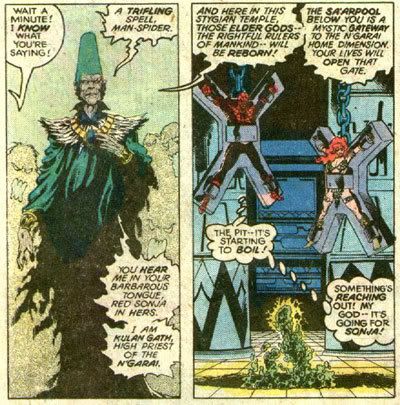
Art by John Byrne and Terry Austin
Kulan Gath returned several years later in a two-issue multi-character team-up in "Uncanny X-Men" #190-191. This time Gath managed to transform the island of Manhattan into a city out of the Hyborian Age, including everyone on the island. Due to the spell they had no memory of their normal reality. The spell affected the X-Men, the New Mutants, and the Avengers. Unaffected were Spider-Man and Doctor Strange. Issue 191 opened with Spider-Man crucified again, this time in the traditional form, and it was apparent that he had been heavily tortured. Many of the characters die in the course of the story, but all was resolved when Doctor Strange combined his abilities with those of Illyana Rasputin to reverse time and erase Kulan Gath's spell from existence. This represents one of the more significant examples of Marvel's licensed properties being directly folded into the Marvel Universe, in this case the pulp, fantasy sword and sorcery realms of Robert E. Howard. Spider-Man also met King Kull in "Marvel Team-Up" #112.
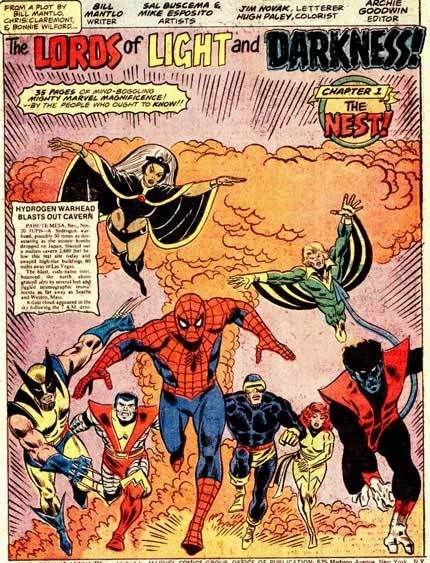
Art by Sal Buscema and Mike Esposito
I've been thinking about "Marvel Team-Up" since I mentioned it in Doctoring Part IV. Then Christopher Knowles of the Secret Sun posted Silver Star, part 5- Iran, the CIA and the Lord of Light where I learned for the first time about Jack Kirby's role in a proposed film based on the 1967 novel "Lord of Light" by Roger Zelazny. Be sure to read Chris' article if you haven't yet for an amazing "truth is stranger then fiction" CIA involvement in the project. The "a-ha" moment for me in this came because amongst the many gems amidst the run of "Marvel Team-Up" is "Marvel Team-Up Annual" #1 from 1976, featuring Spider-Man's first meeting with the full New X-Men team, "The Lords of Light and Darkness", undoubtedly inspired by Zelazny's works, primarily "Lord of Light" due to its Hindu mythological structure, but also the 1969 Egyptian pantheon based "Creatures of Light and Darkness". In the splash above the heroes are before what Zelazny might term "the tall man of smoke who wears a wide hat". Note in this image how the various figures are mostly balanced in pairs, Storm and Banshee, Wolverine and Nightcrawler, and Cyclops and Colossus. This by default leaves key initiator Spider-Man in association with Phoenix, the Goddess herself. I have not read "Lord of Light", or any of Zelazny's novels besides a few of the "Amber" series many years ago, but even the cursory, Cliiff-notes treatment on Wikipedia makes the source material for the Team-Up annual readily apparent.
The plot involves a top-secret government installation called "The Nest" working to solve the energy crisis through use of secret method of irradiating common minerals. A team of eight international scientists were at the Nest working on the project. The developer of the method, Araman Nila, was a devout Hindu. An earthquake struck the underground complex while Nila was performing a delicate procedure, causing the unstable, radioactive compounds to explode.
As chance would have it Peter Parker was part of a press junket following American and Soviet scientists and politicians going to visit the Nest. Even more amazing was the presence on this flight of Professor Xavier and his students, as stand-ins for Reed Richards, Mister Fantastic, who was unable to attend. The plane carrying the visitors flew into the path of the smoke from the destroyed Nest and the controls went haywire due to the radiation. It was then attacked by a squadron of flying robots called Rakks, security droids for the Nest, named for the Hindu demonic entities Rakshasas, here described by Peter Parker as "Guardians of the Gates of Hell". The Rakks cut the nose off the plane with lasers and it dropped into a nosedive. Spider-Man averted disaster by quickly weaving a giant web-parachute to slow the plane's descent.
On the ground the heroes soon discovered the former site of the Nest shielded by a rainbow hued radiation field. The crack in the earth leading to the underground complex was termed a "Hellpit", highly similar to the "Hellwell" of "Lord of Light". The heroes were then attacked by entities calling themselves Yama Dharma and Kali. Kali wields an item called "the Chaos Wheel" that emits maddening, hyper-sonic frequencies, seemingly identical to the skull-wheel used by the Kali in "Lord of Light". The self-styled gods revealed that they brought the plane down in order to capture an individual on board that they term "the One". The One, as you may expect, is Jean Grey/Phoenix.
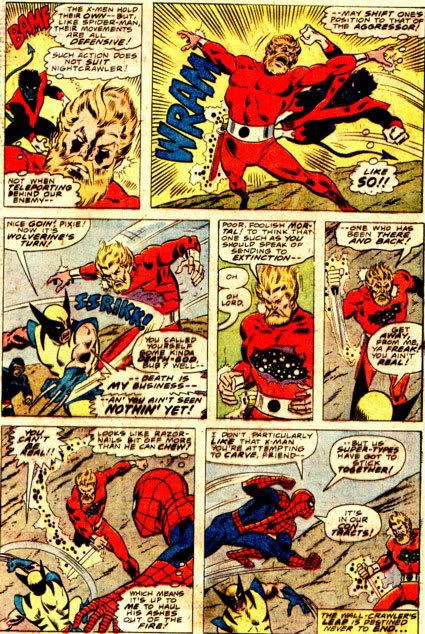
Art by Sal Buscema and Mike Esposito
In this scene Wolverine's claws revealed Yama Dharma's transcendental nature. My god, he's full of stars! Following the proper super hero comic book formula, all the heroes were instantly knocked out by Kali's powerful Chaos Wheel. They awakened suspended and immobile in a force field. This was the perfect moment for some comic book exposition. Spider-Man and the X-Men learned that the powerful explosion filtered through the mind of the Hindu Araman Nila, transforming himself and his fellow scientists into god-like entities based on the templates of Nila's faith.
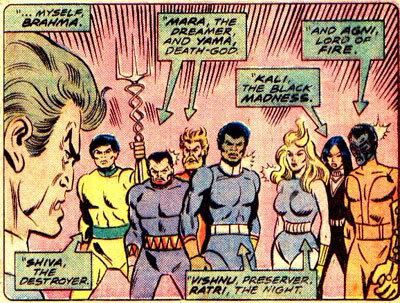
Art by Sal Buscema and Mike Esposito
Note the caduceus styling of Shiva's trident. They further explained that they sensed Jean's great power as the plane approached, and they required her to become their ninth member, completing their ennead. They furthered that their corporeal forms were unstable, in danger of disruption. They needed to transcend or die. To this end they were drawing in "stellar energy" and when they had absorbed enough they would leave the planet. However, this process would leave the Earth a "dying husk", a fact the Lords of Light and Darkness were completely indifferent to. Phoenix was needed to "bind their energies" and stabilize their "path to godhood".
Before this could happen Nightcrawler deduced that the stasis fields were particularly attuned to each captive, so while they couldn't free themselves they could use their powers to free one another. Once Spider-Man and the X-Men were free they quickly subdued the Lords, who were apparently not all that tough as far as godlike beings go. The Lords began to dissolve. Unfortunately, for some reason, their dissolution would also cause the Earth to die. Spider-Man deduced that the only solution was to get the Lords off the planet before it was too late. Cyclops devised a plan to accomplish this, that naturally involved coordinating several of the X-Men's powers.
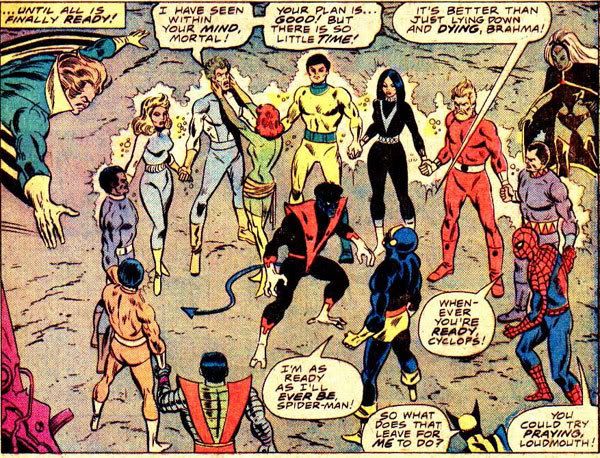
Art by Sal Buscema and Mike Esposito
This involved the many characters forming a circle, a Magic ring. The end result was the Lords transforming into energy and traveling deep into space on one of Cyclops' optic beams, where they finished their evolution, combining to become a new star. "Marvel Team-Up Annual" #1 is not a classic by most standards. Neither writer Bill Mantlo nor artist Sal Buscema are largely considered to be top talents in the field (unfairly in the case of Buscema). However, I find the issue delightful as modern super heroes are brought into conflict with (somewhat) mythological entities, more or less on equal terms, blurring the distinctions between them. In fact, these gods were created in exactly the manner of many if not most of the "science" based super heroes (like Spider-Man, the Hulk, the Flash, etc.). And it is the symbolism of the art of alchemy that underlies this story of transmutation from mortal, to divine, and ultimately to stellar, the ultimate source of all mythologies.
The "Marvel Team-Up" Volume 1 series was a monthly alchemical formula, the chemical wedding of symbolic entities, and primarily initiatory in format. This is apparent by the major use in the title of Spider-Man as well as the Promethean Human Torch. We find synchronistic confirmation of this concept through a very unusual issue, "Marvel Team-Up" #74, published in October of 1978, which featured a meeting of Spider-Man and "Saturday Night Live's" Not Ready For Prime-Time Players, including Bill Murray (see Bill Luminati), again written by Chris Claremont.
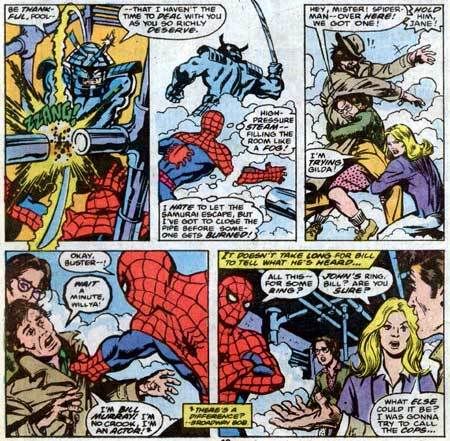
Art by Bob Hall and Marie Severin
That's Jane Curtin and Gilda Radner in this scene with Murray and Spidey. The issue also includes Dan Aykroyd, Laraine Newman (dressed as Ms. Marvel), Garrett Morris (dressed as Thor!), and John Belushi in a samurai duel with the mutant Silver Samurai. The plot involves Belushi accidentally receiving a ring in the mail that he tried on and couldn't remove. The Silver Samurai wanted the ring and hired a group of goons to take over the "Saturday Night Live" studio. As chance would have it Peter Parker and Mary Jane Watson had tickets for that night's show. The host of the show was Stan Lee (the most unlikely element of the issue). Interestingly the Samurai kind of wins this encounter.
This is far from the only instance when Marvel characters encounter real world celebrities. The Human Torch and the Thing once met the Beatles, Kirby once had Captain America and the Falcon taking orders from a dead-ringer for Kissinger, Daredevil had a team-up with Uri Geller and I've mentioned Doctor Strange's friendship with Tom Wolfe, and there are many more. In this instance the Promethean/initiatory character of the roles of Bill Murray intersect with Spider-Man, Mary Jane, and the alchemical qualities symbolized with Silver based characters. Plus the all important Magic Ring. Clearing away all doubt is the magical ability the ring is revealed to confer:

Art by Bob Hall and Marie Severin
Hiyo Silver away!
No comments:
Post a Comment